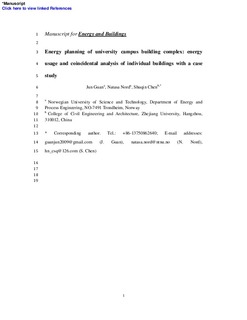Energy planning of university campus building complex: Energy usage and coincidental analysis of individual buildings with a case study
Journal article, Peer reviewed
Submitted version
Permanent lenke
http://hdl.handle.net/11250/2457605Utgivelsesdato
2016Metadata
Vis full innførselSamlinger
Sammendrag
As the demonstration of eco-communities, energy planning becomes more and more important for university campus. However, insufficient energy use data accumulation has been a significant barrier against fully understanding of energy use characteristics, and demand load features of campus buildings, which usually provide the basic support for energy planning from the demand side. A methodology to reveal the features of demand load and energy use of campus building was developed for this purpose. As a case study, both the long-term and real-time data of the electricity, heating, and water usage of a Norwegian university campus were analyzed by the descriptive statistics. On this base, coincidence characteristics of energy and water usage of the entire campus were analyzed, and individual coincidental rates to the campus were also quantified accordingly. The coincidence factors were calculated to be at high levels, which implied that the campus buildings’ usage of energy was quite similar to that of water. Finally, the individual coincidental contribution to total campus energy use was analyzed by the cluster analysis, to identify those buildings with the large potential of operation optimization. The results from this study could be used for the energy planning of cities and other urban energy systems.
